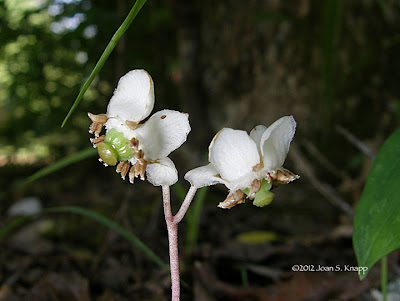 The cluster of flowering plants at the edge of the woods. Only two plants are visible in this photo.
The cluster of flowering plants at the edge of the woods. Only two plants are visible in this photo. Three flowers from the top. It was worthwhile lying on the ground to try to capture photographs of the undersides of the flowers.
Three flowers from the top. It was worthwhile lying on the ground to try to capture photographs of the undersides of the flowers. Plant with three flowers
Plant with three flowers The plant with two flowers
The plant with two flowers The plant with a single flower. This flower was facing to the side, allowing a better view of the underside.
The plant with a single flower. This flower was facing to the side, allowing a better view of the underside. I’ve photographed a series of Pipsissewa flowers ranging from buds to seed pods previously at Fort Yargo State Park.
Chimaphila maculata, native to the eastern United States and Canada, is known by the common names Pipsissewa, Striped Wintergreen, Striped Prince's Pine or Spotted Wintergreen. In Georgia, it’s found mainly in counties in the Piedmont. Chimaphila maculata is one of two Chimaphila species that grows in the southeastern United States. The other species, Chimaphila umbellata (Prince's-pine, Pipsissewa) does not grow in Georgia; it grows south only as far as northern South Carolina. is native to the eastern United States and Ontario and Quebec in Canada.
Click on an image to view a larger image
Identification resources:
- Southeastern Flora: Pipsissewa or Spotted Wintergreen (Chimaphila maculata)
- Natural and Naturalized Plants of the Carolinas and Georgia: Chimaphila maculata
Distribution Map:
- United States Department of Agriculture Plants Database: Chimaphila maculata (Striped Prince's pine)
- University of North Carolina Herbarium: Chimaphila maculata
Related posts:
- Pipsissewa or Spotted Wintergreen (Chimaphila maculata)
No comments:
Post a Comment